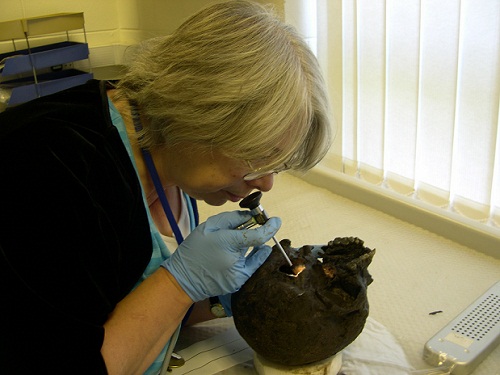
Dr Sonia O’Connor examines the remains of the brain using an endoscope. Credit: University of Bradford.
Scientists have discovered remnants of brain tissue in the skull of an Iron-age man.
The man, aged between 26 and 45 was unearthed during excavations at the University of York in 2008. The marks and fractures on his bones have caused scientists to suspect that he may have been the victim of a ritual killing, where he was hung and decapitated, with his head buried separately from his body.
Professor Matthew Collins from the University of York says the man’s death is suspected to be a ritual killing from the absence of the post-cranium and spinal column damage, indicating that the individual was hung by the neck. “And subsequent dismemberment of the head (probably after death) which appears to have been sawn off with at thin knife.”
Histological studies revealed the remnants of brain matter in the skull, together with lipids and brain specific proteins. The skull itself dates back 2500 years- making it one of the oldest brains in Britain.
A multi-disciplinary team of scientists, led by Dr Sonia O’Connor from the University of Bradford, is investigating how his brain survived while the rest of the soft tissue decayed. They are also examining the lipids and proteins and what they can tell us about the circumstances of man’s death, the environment is which he was buried and the preservation of his brain.
Dr O’Connor said in the press release “The hydrated state of the brain and the lack of evidence for putrefaction suggests that burial, in the fine-grained, anoxic sediments of the pit, occurred very rapidly after death. This is a distinctive and unusual sequence of events, and could be taken as an explanation for the exceptional brain preservation.”
She added “This is the most thorough investigation ever undertaken of a brain found in a buried skeleton and has allowed us to begin to really understand why brain can survive thousands of years after all the other soft tissues have decayed.”






